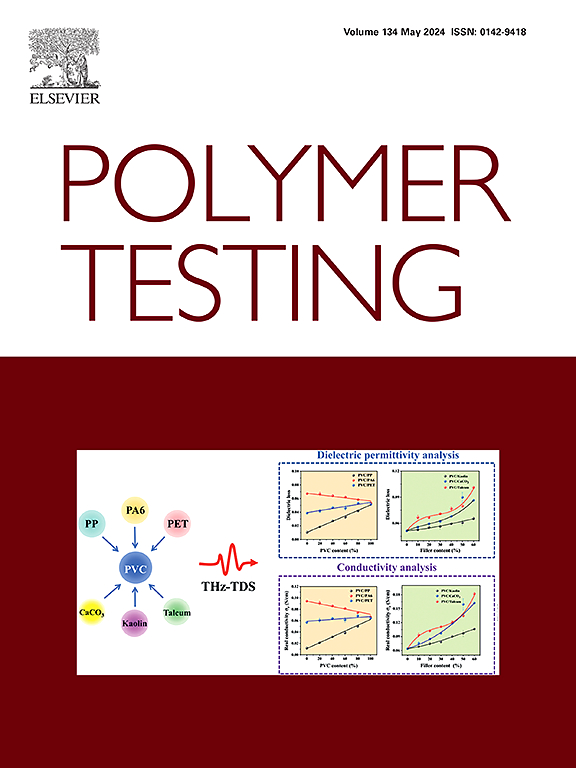不同形状因素硅橡胶样品弹性模量和泊松比特性的压缩和扭转试验
IF 6
2区 材料科学
Q1 MATERIALS SCIENCE, CHARACTERIZATION & TESTING
引用次数: 0
摘要
弹性材料,如硅橡胶,由于其高变形性和粘弹性,在工程应用中得到了广泛的应用。在准静态状态和小变形下,它们的行为可以被认为是纯弹性的,可以用各向同性材料中相互关联的弹性模量、剪切模量和泊松比来表征。虽然存在确定这些特性的标准方法,但已知实验测量受测试样品几何形状的影响。试样几何形状对压缩模量测量的影响已经很清楚,然而,其对剪切模量测量的影响却很少被探索。本研究探讨了圆柱形样品的尺寸如何影响压缩模量和剪切模量的实验测定,从而影响泊松比。用动态力学分析仪和流变仪分别对不同直径和长度的硅橡胶试样进行了压缩和扭转试验。结果证实,压缩模量和剪切模量都受到试样几何形状的影响,导致泊松比的值不切实际。为了考虑这些影响,提出了一种用于剪切模量测量的修正模型,以补充现有的压缩试验修正。该模型成功地描述了实验趋势,并提供了更可靠的泊松比估计,与几乎不可压缩弹性体的理论预期一致。这些发现强调了在压缩和扭转测试中考虑几何效应的重要性,并为提高弹性材料力学表征的准确性提供了一个框架。本文章由计算机程序翻译,如有差异,请以英文原文为准。
Compression and torsion testing for elastic moduli and Poisson's ratio characterization in silicone rubber samples with varying shape factors
Elastomeric materials, such as silicone rubber, are widely used in engineering applications due to their high deformability and viscoelastic properties. Under quasistatic regime and small deformations their behavior can be considered purely elastic and can be characterized by the elastic modulus, shear modulus, and Poisson's ratio, which are interrelated in isotropic materials. Although standard methodologies exist for determining these properties, experimental measurements are known to be affected by the geometry of the tested samples. The influence of sample geometry on compressive modulus measurements is well understood, however, its effect on shear modulus measurements is less explored. This study investigates how the dimensions of cylindrical samples influence the experimental determination of both the compressive and shear moduli and, consequently, Poisson's ratio. Compression and torsion tests are performed on silicone rubber samples of varying diameters and lengths using a dynamic mechanical analyzer and a rheometer respectively. The results confirm that both the compressive and shear moduli are affected by sample geometry, leading to unrealistic values of Poisson's ratio. To account for these effects, a correction model is proposed for shear modulus measurements, complementing existing corrections for compressive tests. The model successfully describes experimental trends and provides a more reliable estimation of Poisson's ratio, aligning with theoretical expectations for nearly incompressible elastomers. These findings emphasize the importance of considering geometric effects in compressive and torsion tests and provide a framework for improving the accuracy of mechanical characterization in elastomeric materials.
求助全文
通过发布文献求助,成功后即可免费获取论文全文。
去求助
来源期刊

Polymer Testing
工程技术-材料科学:表征与测试
CiteScore
10.70
自引率
5.90%
发文量
328
审稿时长
44 days
期刊介绍:
Polymer Testing focuses on the testing, analysis and characterization of polymer materials, including both synthetic and natural or biobased polymers. Novel testing methods and the testing of novel polymeric materials in bulk, solution and dispersion is covered. In addition, we welcome the submission of the testing of polymeric materials for a wide range of applications and industrial products as well as nanoscale characterization.
The scope includes but is not limited to the following main topics:
Novel testing methods and Chemical analysis
• mechanical, thermal, electrical, chemical, imaging, spectroscopy, scattering and rheology
Physical properties and behaviour of novel polymer systems
• nanoscale properties, morphology, transport properties
Degradation and recycling of polymeric materials when combined with novel testing or characterization methods
• degradation, biodegradation, ageing and fire retardancy
Modelling and Simulation work will be only considered when it is linked to new or previously published experimental results.
 求助内容:
求助内容: 应助结果提醒方式:
应助结果提醒方式:


